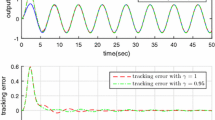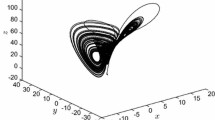Abstract
The elementary fractional-order models are the extension of first and second order models which have been widely used in various engineering fields. Some important properties of commensurate or a few particular kinds of non-commensurate elementary fractional-order transfer functions have already been discussed in the existing studies. However, most of them are only available for one particular kind elementary fractional-order system. In this paper, the stability and resonance analysis of a general kind non-commensurate elementary fractional-order system is presented. The commensurate-order restriction is fully released. Firstly, based on Nyquist’s Theorem, the stability conditions are explored in details under different conditions, namely different combinations of pseudo-damping (ζ) factor values and order parameters. Then, resonance conditions are established in terms of frequency behaviors. At last, an example is given to show the stable and resonant regions of the studied systems.
Similar content being viewed by others
References
Y. Q. Chen, K. L. Moore, Analytical stability bound for a class of delayed fractional-order dynamic systems. Nonlinear Dynam. 29 No 1–4 (2002), 191–200.
Z. Dai, P. Ying, H. A. Mansy, R. H. Sandler, T. J. Royston, A model of lung parenchyma stress relaxation using fractional viscoelasticity. Med. Eng. Phys. 37 No 8 (2015), 752–758.
S. Das, S. Das, A. Gupta, Fractional order modeling of a PHWR under step-back condition and control of its global power with a robust PIλ Dμ controller. IEEE Trans. Nucl. Sci. 58 No 5 (2012), 2431–2441.
W. Deng, C. Li, J. Lu, Stability analysis of linear fractional differential system with multiple time delays. Nonlinear Dynam. 48 No 4 (2007), 409–416.
A. S. Elwakil, Fractional-order circuits and systems: An emerging interdisciplinary research area. IEEE Circ. Syst. Mag. 10 No 4 (2010), 40–50.
J. D. Gabano, T. Poinot, H. Kanoun, LPV continuous fractional modeling applied to ultracapacitor impedance identification. Control Eng. Pract. 45 (2015), 86–97.
R. K. H. Galvao, S. Hadjiloucas, K. H. Kienitz, H. M. Paiva, Fractional order modeling of large three-dimensional RC networks. IEEE Trans. Circuits-I. 60 No 3 (2013), 624–637.
F. Ge, Y. Q. Chen, C. Kou, I. Podlubny, On the regional controllability of the sub-diffusion process with caputo fractional derivative. Fract. Calc. Appl. Anal. 19 No 5 (2016), 1262–1281; DOI: 10.1515/fca-2016-0065; https://www.degruyter.com/view/j/fca.2016.19.issue-5/issue-files/fca.2016.19.issue-5.xml.
S. E. Hamamci, An algorithm for stabilization of fractional-order time delay systems using fractional-order PID controllers. IEEE Trans. Automat. Contr. 52 No 10 (2007), 1964–1969.
A. B. Hmed, M. Amairi, M. Aoun, Stability and resonance conditions of the non-commensurate elementary fractional transfer functions of the second kind. Commun. Nonlinear Sci. 22 No 1–3 (2015), 842–865.
E. Ivanova, X. Moreau, R. Malti, Stability and resonance conditions of second-order fractional systems. J. Vib. Control 24 No 4 (2018), 659–672.
Z. Jiao, Y. Q. Chen, Stability analysis of fractional-order systems with double noncommensurate orders for matrix case. Fract. Calc. Appl. Anal. 14 No 3 (2011), 436–453; DOI: 10.2478/s13540-011-0027-3; https://www.degruyter.com/view/j/fca.2011.14.issue-3/issue-files/fca.2011.14.issue-3.xml.
G. Lazović, Z. Vosika, M. Lazarević, J. Simic-Krstić, D. Koruga, Modeling of bioimpedance for human skin based on fractional distributed-order modified cole model. FME T. 42 No 1 (2014), 74–81.
Y. Li, Y. Q. Chen, I. Podlubny, Mittag–leffler stability of fractional order nonlinear dynamic systems. Automatica 45 No 8 (2009), 1965–1969.
L. Liu, S. Tian, D. Xue, T. Zhang, Y. Q. Chen, Continuous fractional-order Zero Phase Error Tracking Control. ISA T. 75 (2018), 226–235.
L. Liu, D. Xue, S. Zhang, Closed-loop time response analysis of irrational fractional-order systems with numerical Laplace transform technique. Appl. Math. Comput. 350 (2018), 133–152.
L. Liu, S. Zhang, D. Xue, Y. Q. Chen, Robust stability analysis for fractional-order systems with time delay based on finite spectrum assignment. Int. J. Robust. Nonlin. 29 No 8 (2019), 2283–2295.
A. M. Lopes, J. A. T. Machado, E. Ramalho, V. Silva, Milk characterization using electrical impedance spectroscopy and fractional models. Food Anal. Method. 11 No 3 (2018), 901–912.
R. L. Magin, Fractional Calculus in Bioengineering. Begell House Redding (2006).
R. Malti, X. Moreau, F. Khemane, Resonance and stability conditions for fractional transfer functions of the second kind. In: New Trends in Nanotechnology and Fractional Calculus Applications, Dordrecht (2010), 429–444.
R. Malti, X. Moreau, F. Khemane, A. Oustaloup, Stability and resonance conditions of elementary fractional transfer functions. Automatica 47 No 11 (2011), 2462–2467.
A. Oustaloup, J. Sabatier, P. Lanusse, R. Malti, P. Melchior, X. Moreau, M. Moze, An overview of the CRONE approach in system analysis, modeling and identification, observation and control. In: Proc. of the 17th World Congress. Seoul (2008), 14254–14265.
I. Petras, Stability of fractional-order systems. Fract. Calc. Appl. Anal. 10 No 3 (2008), 269–298.
I. Podlubny, Fractional Differential Equations. Academic Press, San Diego (1999).
D. Sierociuk, T. Skovranek, M. Macias, I. Podlubny, I. Petras, A. Dzielinski, P. Ziubinski, Diffusion process modeling by using fractional-order models. Appl. Math. Comput. 257 No C (2015), 2–11.
V. E. Tarasov, Fractional hydrodynamic equations for fractal media. Ann. Phys. 318 No 2 (2005), 286–307.
M. S. Tavazoei, M. Haeri, S. Bolouki, M. Siami, Stability preservation analysis for frequency-based methods in numerical simulation of fractional order systems. SIAM J. Numer. Anal. 47 No 1 (2008), 321–338.
D. Valerio, J. S. da Costa, A review of tuning methods for fractional PIDs. In: Proc. of 4th IFAC Workshop on Fractional Differentiation and its Applications, FDA. Badajoz, Spain, 10 (2010), 1–5.
B. Vinagre, I. Podlubny, A. Hernandez, V. Feliu, Some approximations of fractional order operators used in control theory and applications. Fract. Calc. Appl. Anal. 3 No 3 (2000), 231–248.
D. Xue, Fractional-order Control Systems Fundamentals and Numerical Implementations. De Gruyter (2017).
J. M. P. Zerpa, A. Canelas, B. Sensale, D. B. Santana, R. L. Armentano, Modeling the arterial wall mechanics using a novel high-order viscoelastic fractional element. Appl. Math. Model. 39 No 16 (2015), 4767–4780.
S. Zhang, L. Liu, X. Cui, Robust FOPID controller design for fractional-order delay systems using positive stability region analysis. Int. J. Robust. Nonlin. 29 No 15 (2019), 5195–5212.
S. Zhang, Y. Yu, H. Wang, Mittag-Leffler stability of fractional-order Hopfield neural networks. Nonlinear Anal-Hybri. 16 (2015), 104–121.
Author information
Authors and Affiliations
Corresponding author
About this article
Cite this article
Zhang, S., Liu, L., Xue, D. et al. Stability and Resonance Analysis of a General Non-Commensurate Elementary Fractional-Order System. Fract Calc Appl Anal 23, 183–210 (2020). https://doi.org/10.1515/fca-2020-0007
Received:
Revised:
Published:
Issue Date:
DOI: https://doi.org/10.1515/fca-2020-0007




